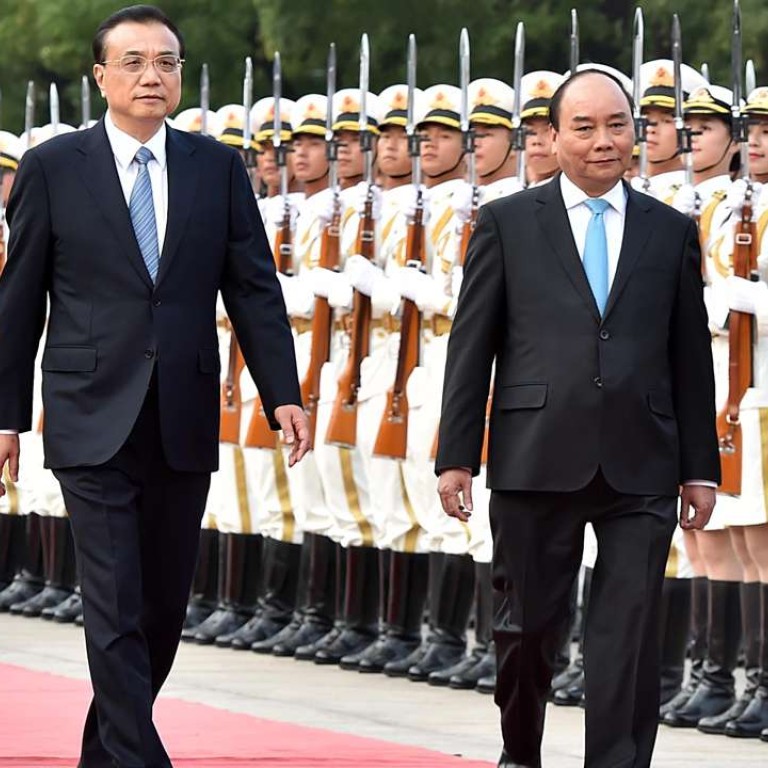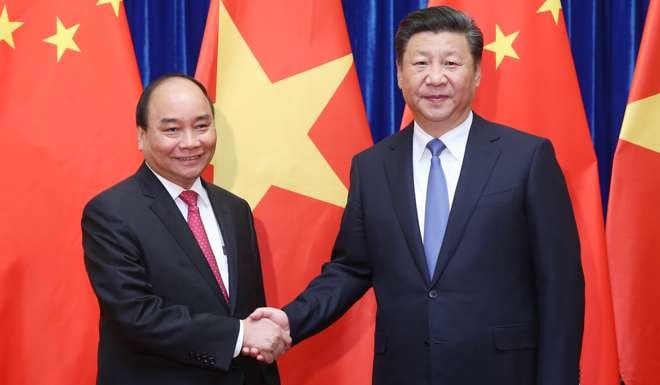
Can China’s charm offensive mend its fractured ties with communist neighbour Vietnam?
Vietnamese Prime Minister given red carpet treatment in Beijing amid frosty relations between two nations over sovereignty disputes in South China Sea
But analysts cautioned that relations between Beijing and Hanoi remain difficult despite the positive appearance projected over the past week.
Diplomatic observers said Phuc’s trip to China, which ended on Thursday, shows Beijing values the geopolitical importance of Hanoi, a key rival claimant to waters in the South China Sea.
Beijing is also trying to use chequebook diplomacy and economic incentives to mend frayed ties between the two nations, analysts said.
Setting aside their bitter differences on maritime disputes, Beijing rolled out the red carpet for Phuc, the first Vietnamese leader to visit China since a major reshuffle in Hanoi earlier this year.
In an unusual gesture to showcase the special relationship between the Communist neighbours, Phuc was received by five out of seven Politburo Standing Committee members during his six-day trip, including President Xi Jinping and Premier Li Keqiang.

Phuc, who took a tougher stance towards China in the wake of the South China Sea ruling in July by the Permanent Court of Arbitration in The Hague, also markedly toned down his rhetoric and pledged that ties with Beijing would remain Hanoi’s top diplomatic priority.
In return, Chinese leaders promised to further deepen trade ties and increase investment in Vietnam, which is poised to become China’s top trading partner in Southeast Asia this year.
Xu Liping, a researcher at the Chinese Academy of Social Sciences, said Phuc’s trip marked a new chapter for the Sino-Vietnamese relations as “both sides reached an understanding that they could not afford to enter into conflicts over the maritime row”.
“Considering their ever close trade ties, it’s obvious that their common interests far outweigh their differences. It’s about time both nations look beyond the South China Sea dispute and rebuild their trust,” he said.
Gu Xiaosong, a Vietnam expert at the Guangxi region’s academy of social sciences, said that even though the two nations’ political relations were still marred by the maritime dispute and ideological differences, their leaders were keen to ease tensions and forge close business and economic ties.
“Clearly peace and stability in the South China Sea is in the interests of both nations and China-Vietnam ties will stabilise for a while,” he said.
The easing of tensions between China and Vietnam will also help cool other strained relations in the region over maritime dispute, Gu added.
Analysts noted that President Xi has pledged to promote maritime cooperation between the two nations in disputed waters claimed by both nations.
China and Vietnam launched a joint inspection in December of the terrain and geological conditions near the mouth of the Beibu Gulf, also known as Gulf of Tonkin in Vietnam.

Other analysts, however, said relations between the two sides have been severely damaged by their sovereignty disputes in the South China Sea and efforts to mend ties would prove difficult.
Alexander Vuving, a professor at the Asia-Pacific Centre for Security Studies in Honolulu, said their relations passed a point of no return in 2014 with the crisis triggered by China’s deployment of an oil rig in disputed waters, which plunged ties to a new low.
“The positive appearance in relations between China and Vietnam serves the interests of both nations, but it belies the reality of their relationship,” he said.
“Since then, despite efforts by both sides to arrange more talks between their leaders, mutual trust remains low. What China has done since in the South China Sea has only deepened Vietnamese mistrust,” he said.
He also noted that China was unlikely to drop its assertive stance in the South China Sea, which means tensions may escalate again between China and Vietnam and other Southeast Asian nations.
Professor Carl Thayer, an expert in Southeast Asia at the University of New South Wales in Australia, said Vietnam’s prime minster was determined to obtain a Chinese commitment to respect the status quo and not engage in further militarisation in the South China Sea.
“All Phuc’s visit can hope to accomplish is to keep working level meetings related to maritime disputes between the two sides on track and to increase confidence building measures.
“Vietnam is keen to ensure the regional environment remains conducive to its economic development. Vietnam views China as one of the major powers that form an important constellation for framing Vietnam’s foreign policy,” he said.
While easing tensions with Beijing, Hanoi has in recent months also sought to improve ties with the United States and upgraded its relationship with other major powers such as Japan, India and France.
“After the visit of Vietnam’s Communist Party leader Nguyen Phu Trong to the United States in 2015, and the visit of US President Obama to Vietnam this year, many in the Vietnamese leadership now trust the United States more than they trust China. This is the reverse of what was the case just a few years ago,” said Vuving.

